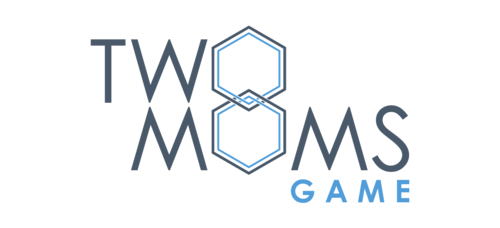A route building game where players are aspiring mountain climbers looking to make the best new climbing route up the mountain
60-90 minutes
Designer: Kate Otte
Artist: Kate Otte
Publisher: Self-Published
We don’t get to review a lot of indie games, so finding one that is just so good is a real treat. For us, it was a great throwback to summer camp and girlscouts, but you don’t have to be an avid climber to enjoy the unique theme, well-oiled gameplay, and thoughtful balance in First Ascent.
First Ascent is great debut game for first-time designer Kate Otte and is coming to Kickstarter June 15th 2021. Read on for what we like about this medium-weight game.
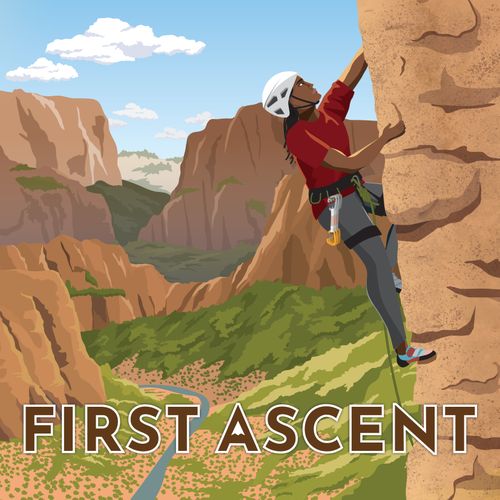
Gameplay Overview
This is a general overview to provide context for the review, not an in-depth how to play. Some rules may be glossed over or missing.
In First Ascent, players are mountain climbers looking to stake their claim to fame by creating a new climbing route on an unexplored mountain. They must navigate pitches of varying difficulty while accomplishing both personal and shared objectives.
Setup
The central board is set up with the mountain divided into two sections: the Apron (bottom half) and the Headwall (top half), separated by the Ledge.
The action spaces players will traverse over the mountain are semi-random hexes shuffled and distributed at the beginning of the game.
Cool Design: The semi-random setup means difficulty level of a certain area remains the same, but the actual space and its requirements changes with each game. It’s a neat way to make sure each game is balanced.
All hexes in the Apron begin face up. Hexes in the Headwall begin face down. When a player climbs to a pitch adjacent to the Ledge (third row), then hexes in the Headwall immediately get flipped face up.
Each player gets a character board with a unique ability and a tracker for water and “psych”. Along with assets gained from cards, water and psych will be required to climb the mountain.
Pro Tip: The asymmetric abilities associated with the different characters can be really powerful when considered as part of your strategy. Choose wisely!
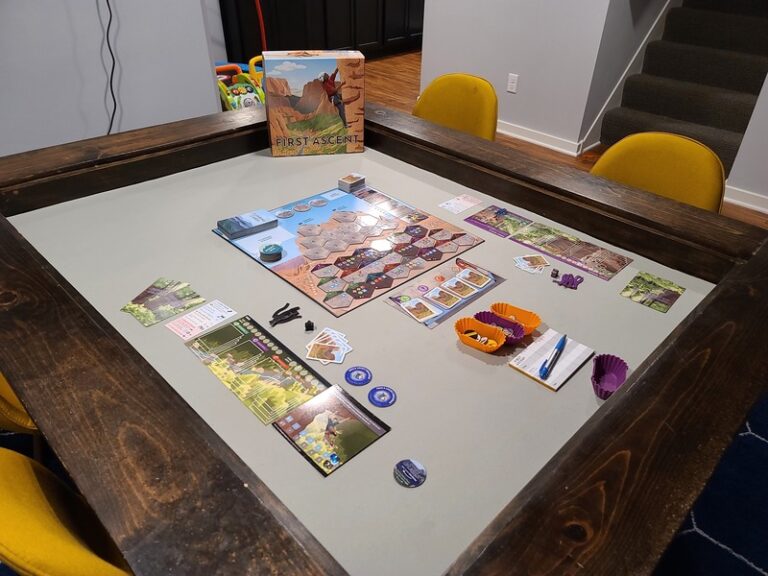
Game Flow
First Ascent is played over three phases: the Climb Phase, the Follow Phase, and the Rerack Phase.
Climb Phase: Climb the Mountain!
During this phase, players may choose to either climb or rest (more on “rest” later).
Each hex (aka “pitch”) has a combination of assets required for it to be successfully climbed. Assets might include cards from your hand and/or water or psych from the trackers on your player board.
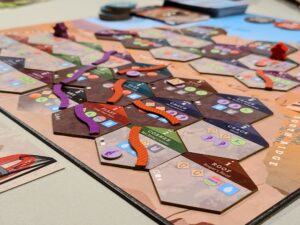
To climb the mountain, players do the following in turn order:
- Move your climber to an adjacent, unoccupied pitch you intend to climb
- Does not necessarily have to be “up” – you can go sideways or down the mountain
- You can’t climb a pitch that has another player currently on it
- You can’t climb a pitch you’ve already climbed (tracked by rope markers)
- You can climb a pitch another player has already climbed (has their rope marker)
- If you’re 2nd to the pitch, subtract one asset of your choice. 3rd – subtract 2 assets. 4th – you’re kinda late to the party, but subtract 3 assets.
- This pitch will be worth one less point per player that was there before you at the end of the game
- Lay down cards to your player mat matching the assets needed to climb the pitch. Move water/psych resource markers on your player tracker if applicable
- Risk it! – If you are short any one asset (including water/psych), you can roll the risk die which may require you to pay additional resources or give cards to an opponent
- As long as you can pay the cost of the risk die, you succeed in climbing the pitch
- If you cannot pay the costs of the risk die, you can’t climb and your turn is over. You get the assets back you would have paid if you were successful
- Risk it! – If you are short any one asset (including water/psych), you can roll the risk die which may require you to pay additional resources or give cards to an opponent
- If you met all the requirements:
- Your climber meeple stays on the pitch; place a rope marker on the pitch you just came from
- Draw a climbing card
- Choose one of the options on the card to resolve.
- If you cannot fulfil the requirements of the card, only draw one card in the Rerack Phase
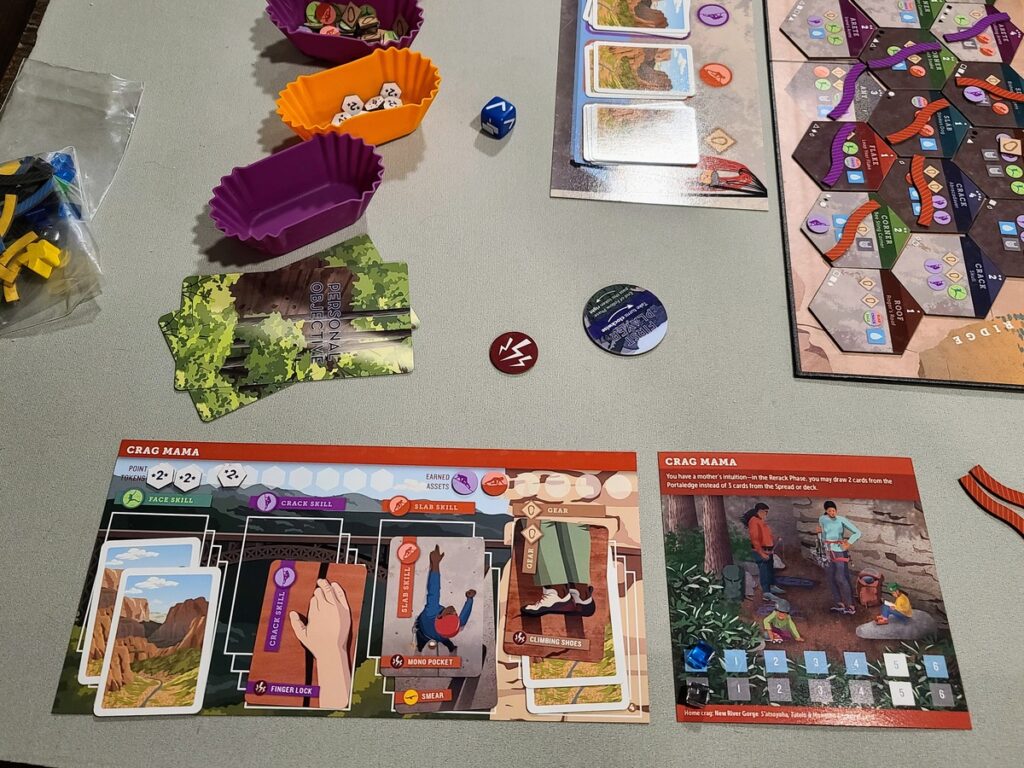
Follow Phase: Clean Up
Players simultaneously:
- Check for matching technique symbols on face-up cards on your player board
- 3 matching symbols = 2 points
- Check for earned assets: four cards of an asset type can be discarded for a skill/gear token
- Place the token on your player board. This now permanently counts toward future climbing requirements
- Flip the remaining cards on you player mat face-down
Rerack Phase: Gain Assets
Starting with the first player, choose three cards using any combination of cards face-up in the spread or random from the draw deck. Before the next player chooses their cards, refill the face-up spread.
Pro Tip: you can discard 3 matching cards during your turn for 1 card of a different type. This is handy when you’re especially desperate.
Concept: Resting
If you do not have enough assets to climb a pitch during the climb phase, or you want to save up assets for a harder pitch, you can Rest. Lay your climber down so they can nap.
- Do not play cards to your player mat and do not do the Follow Phase
- In the Rerack Phase, you may gain 4 assets in any combination of cards and/or water and psych
- Draw cards for Portaledge instead of the spread
- Gain water or psych
Concept: Objectives
Objectives are another way to gain points for end game scoring.
- Personal objectives: At the beginning of the game, each player will be given two personal objective cards but may only score one at game end
- Shared objectives: Can be achieved by any/multiple players
Game End
A game of First Ascent ends once a player has used all their rope markers and successfully climbed their 8th pitch. Complete the Climbing and Follow Phases, but do not rerack.
Ways to get points:
- Pitches – the first player on each pitch scores full points, each subsequent player scores one less
- Objectives – shared and personal
- Only score one personal objective
- Points from Technique symbols
- Summit bonus – 1 bonus point for reaching a summit
The player with the most points at the end of the scoring wins.
Pro Tip: Reaching the summit isn’t worth much, so it’s not even necessary. If it makes more sense to create a more meandering path that goes sideways or up and down, go for it!
What do we think?
First Ascent is a route building and resource management game by first time designer and artist Kate Otte. But don’t let the fact that it’s a debut game fool you. When playing First Ascent you can feel the passion that went into this game. It is one of the few games we have ever looked at each other and said “Wow, I can really feel the love in this project”. It boasts an inclusive, fun, often funny, theme with solid gameplay and interesting mechanisms.
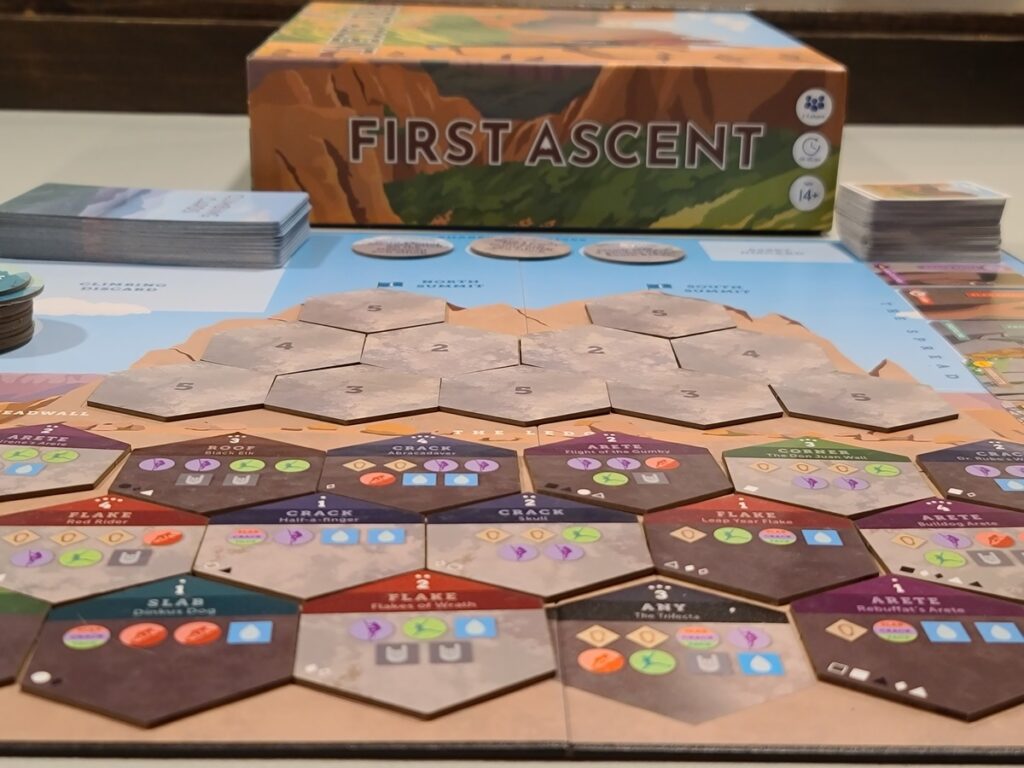
What did we like?
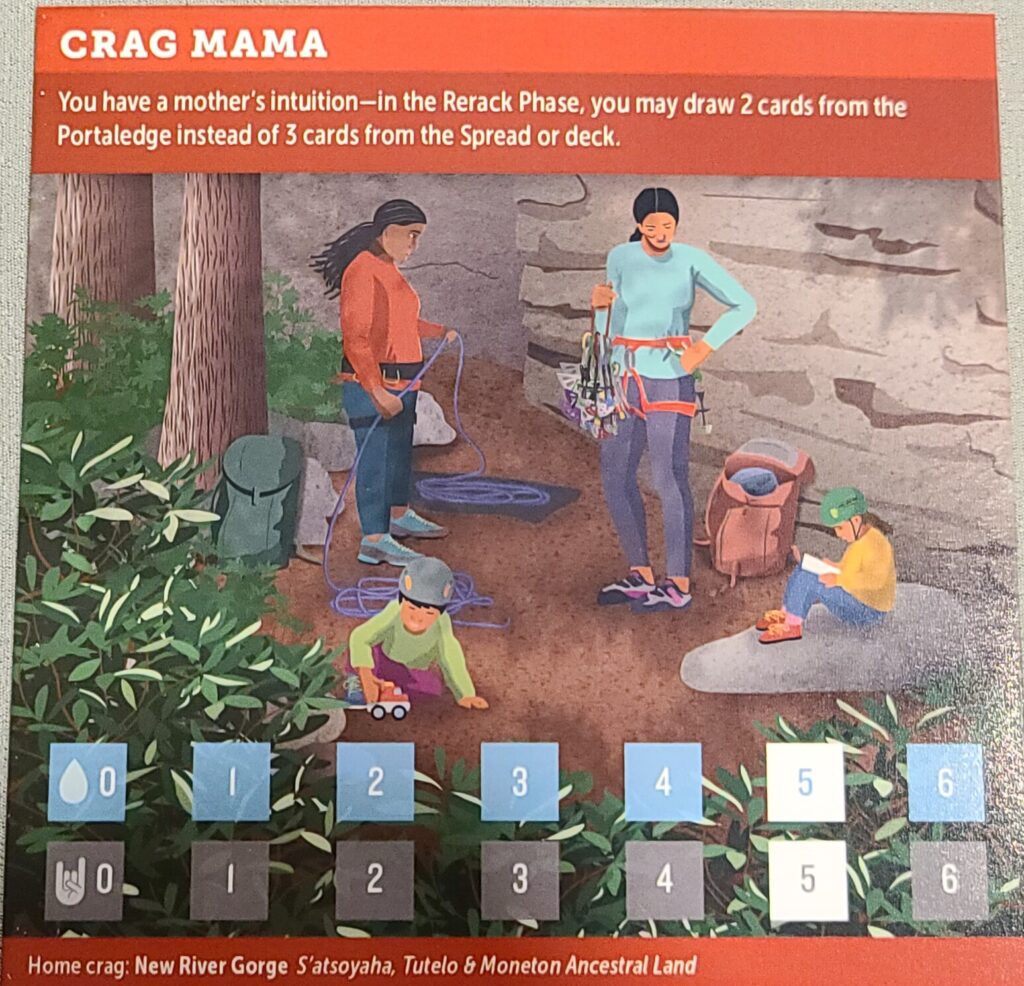
Game Play
First Ascent does a wonderful job of walking the line between satisfying the medium weight euro crowd while introducing enough random elements so that no one ever feels like they’re so far behind they can’t win. This is a great feat for a midweight game as it keeps the game approachable without taking away the strategy.
The mechanisms of set collection, route building, and engine building all work really well together. You’re trying to build your “engine” by laying down four cards of a kind to gain a permanent token that reduces future costs, while also trying to avoid Resting (it’s a bummer) and plan your route to get the most points. You also have to balance all that with trying to achieve personal goals (which require you to climb particular pitches) with shared goals (which require you to climb particular types of pitches or particular locations). The rules themselves are very straightforward, but the cost/benefit decisions you have to make can be really tough and part of what makes this game so fun. Newer and casual gamers will have fun just playing, while experienced gamers can do a deep dive into maximizing their strategy.
Theme/Setting
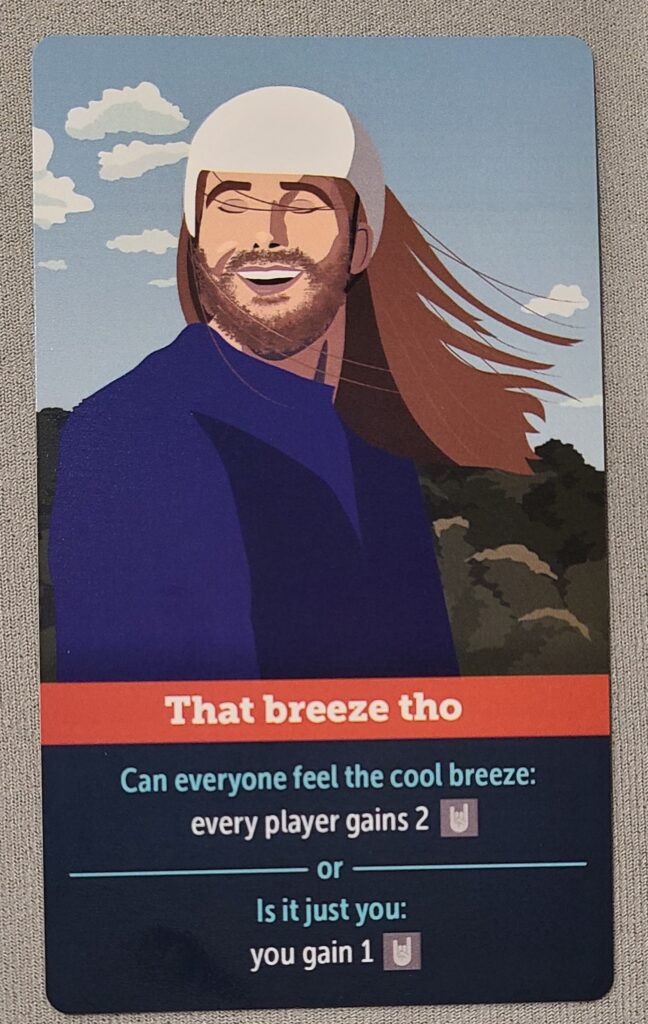
Rock/mountain climbing is such a refreshing theme. The theme and setting are reinforced with the language and terminology on the cards. Some of the climbing cards have legitimately funny situations that climbers might face while scaling a mountain, including running into birds or having to pee on a cliff. There’s definitely a sense of humor built in that shines through. We found ourselves chuckling not only at the situations described on some of the climbing cards, but also the artwork.
Fun fact: First Ascent comes with a glossary of climbing turns, which we felt was a really nice touch and would eagerly look up terms we were unfamiliar with.
Artwork
The art diversity and inclusivity is probably our favorite thing about First Ascent. It is clear that Kate Otte took time to be intentionally inclusive. Artwork depicts people across races, age groups, body types, and disabilities. Many of the characters are based on real-life climbers. This is a game where anyone can sit down and see themselves represented as a badass mountain climber. We also appreciated the small touches, like adding the indigenous names for certain climbing locations alongside the current official names.
Aside from the diversity, the artwork itself is super fun. The images carry that same sense of humor that’s present throughout the game (see the breeze dude above and his expression of pure bliss).
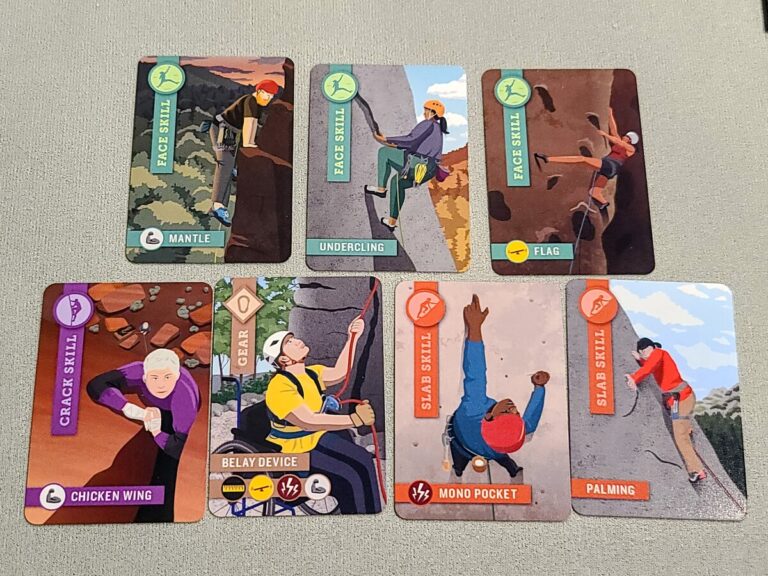
What didn't we like?
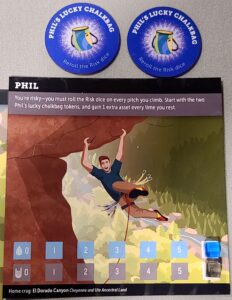
In a two player game, resting felt more punishing than we think it would be in a multi-player game. Missing out on an opportunity to climb was a bigger hit than the advantage of the extra cards from the Portaledge. Resting is also the most consistent way to gain water or psych assets but it can be PAINFUL to have to rest to just get some water. (Okay, so writing this, it seems appropriately thematic, but Sarah’s feelings are still hurt for having to rest on a turn when Emily triggered game end).
The variable player abilities are super unique and fun to play with and add a lot of re-playability to the game. But some abilities are probably not best to play in a two player game. Take Phil for example. Phil’s ability requires the player to roll the Risk die on every pitch climbed (Phil’s a risky dude). However, one of the consequences of the risk die is to give an opponent two cards. In a two player game, your choice of opponent is severely limited. Phil is probably better suited to a 3+ player game.
Who will like this game?
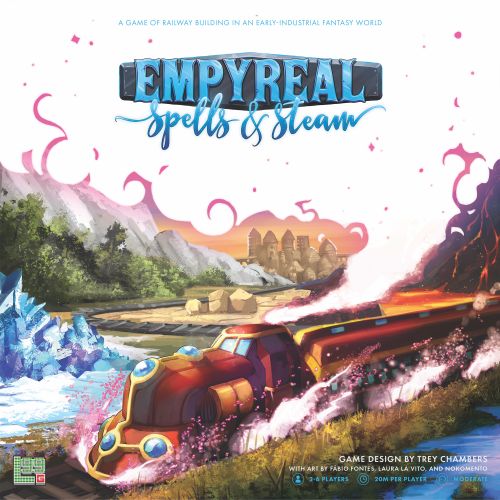
First Ascent accomplishes what many midweight games aim to do – find that balance that will make sure both experienced and newer gamers have fun. This is challenging enough to be engaging and straightforward enough that it’s a fairly quick play. Players looking to have fun while working their brains in a relatively quick-playing game will enjoy First Ascent.
If you’re a newer player looking for a step-up in strategy from Ticket to Ride you might like First Ascent. It also is slightly more challenging than similar route builder Empyreal: Spells & Steam, but has a similar feel. But the quick, mid-weight gameplay and Euro-style focus on strategy means First Ascent also has a place on game shelves among games like Castles of Burgundy, Ragusa, or Concordia.
Sarah's Take
First Ascent is a really special game. It’s a game I can see us bringing out in a variety of different situations and people and having a good time no matter what.
Are the game mechanisms new or innovative? No. But they don’t need to be. The mechanisms and the theme integrate so well together that the game is a pure joy to play.
Doubling down on the inclusivity – representation matters. Everyone playing First Ascent will be able to sit down at the table and see themselves represented in the artwork in some way and that is truly special.
Emily's Take
First Ascent is as solid as they come. It’s crazy thoughtful down to a ton of the climbing theme-related details and some of the smaller rules that clearly were implemented to make the game work at its best.
I can’t talk enough about how fun the climbing cards make this game. As a mechanism, they’re interesting, but the stories and the situations described on them add so much humor. I literally laughed for about 30 seconds when I drew “pee off the ledge”, and when Sarah got “that breeze tho” (pictured above) she had to show me the picture on it immediately because it’s so perfect.
I also like that you can dive in to the strategy without losing any of the fun factor. Some games in this weight class get bogged down with details, when really you just need several good short game vs. long game types of choices you have to weigh in your head.
Breakdown
Rulebook / Learning the game
The rulebook is well laid out and easy to follow. We watched a How to Play video from the game producers [HERE].
We did find ourselves having to reference things in the rulebook from time to time. For the most part this was easy to do, but there were a couple things (like laying down climbing rope on the pitches you’ve already climbed) that were only mentioned in image captions or were presented with more emphasis in the how to play video vs the rulebook. Overall, this is a very minor gripe and didn’t impact our enjoyment of the first game.
A couple neat features of the rulebook are an intro game/guide game for players less familiar with the game concepts and a glossary of climbing terms.
First Play
Our first play went off without a hitch. We quickly figured out how to combo technique icons for points and to gain skills.
Subsequent Plays
As we played more we were able to make better decisions and score higher. It’s still not a super high-scoring game (40-60ish typically at 2-player), but that makes gameplay tighter.
Parent Perspective
Interruptions
There is some interaction in this game, but it can almost all be done with the other player(s) gone from the table. Ex. you might climb on a pitch someone else has already climbed. This meant that one of us could very easily step away when it was the others turn during the Climbing and/or Follow Phase. There are some exceptions, but mostly it was friendly towards interruptions.
Time Investment
We are able to play a 2 player game of First Ascent in just over an hour including step up/clean up and kiddo interruptions. We did not get a chance to play a higher player count game, but we would anticipate adding about 15 minutes per additional player.
Life Fit
First Ascent is a super chill game that will be hitting our table after a long work day or when we are hanging out with gaming friends but also want to spend time catching up while playing.
Rating
8/10
When people ask for a game that is fun, challenging, strategic, and also represents all the people that make up our wonderfully diverse world – this is what they are asking for.
*See our rating scale HERE
Click through for more posts, or follow us on social media to see what we’re playing and for new post updates!
